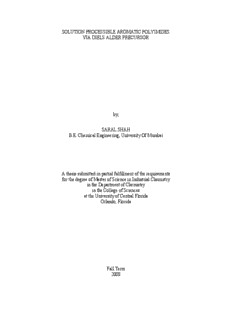
solution processible aromatic polyimides via diels alder precursor PDF
Preview solution processible aromatic polyimides via diels alder precursor
UUnniivveerrssiittyy ooff CCeennttrraall FFlloorriiddaa SSTTAARRSS Electronic Theses and Dissertations, 2004-2019 2008 SSoolluuttiioonn PPrroocceessssiibbllee AArroommaattiicc PPoollyyiimmiiddeess VViiaa DDiieellss AAllddeerr PPrreeccuurrssoorr Saral Shah University of Central Florida Part of the Chemistry Commons Find similar works at: https://stars.library.ucf.edu/etd University of Central Florida Libraries http://library.ucf.edu This Masters Thesis (Open Access) is brought to you for free and open access by STARS. It has been accepted for inclusion in Electronic Theses and Dissertations, 2004-2019 by an authorized administrator of STARS. For more information, please contact [email protected]. SSTTAARRSS CCiittaattiioonn Shah, Saral, "Solution Processible Aromatic Polyimides Via Diels Alder Precursor" (2008). Electronic Theses and Dissertations, 2004-2019. 3636. https://stars.library.ucf.edu/etd/3636 SOLUTION PROCESSIBLE AROMATIC POLYIMIDES VIA DIELS ALDER PRECURSOR by, SARAL SHAH B.E. Chemical Engineering, University Of Mumbai A thesis submitted in partial fulfillment of the requirements for the degree of Master of Science in Industrial Chemistry in the Department of Chemistry in the College of Sciences at the University of Central Florida Orlando, Florida Fall Term 2008 © 2008 Saral Shah ii ABSTRACT Aromatic polyimides are interesting materials since they possess outstanding key properties such as thermoxidative stability, high mechanical strength, high modulus, excellent electrical properties, and superior chemical resistance. However, their low solubility makes them difficult to characterize, process and obtain high molecular weight polymer. In this report, we synthesized a series of precursor polymers that contains Diels-Alder (DA) adducts of anthracene. Different dienophiles were tried. These precursor polymers are soluble in common organic solvents such as chloroform and can be easily processed to thin films. Heating the film above 215 degree induce retro-DA reaction, which generated the fully aromatic polyimides in situ. The solid-state retro-DA reactions were monitored by ATR-FTIR and UV-Vis spectra. The fully aromatic polyimides are highly stable and their thin films are insoluble in organic solvents. Profilometry and AFM studies showed that after the thermal treatment, the films are smooth and pin-hole free, while the volumes decreased with a percentage close to the weight loss caused by retro-DA reaction. These Polymers can have a wide range of potential applications from thermal patterning polymers to organic photovoltaics. iii To my parents, who gave all I value, some debts are never repaid in full measure iv ACKNOWLEDGMENTS I wish to express my sincere thanks to my advisor, Dr. Yi Liao, for his support, guidance, thoughtful discussions and limitless patience. Without his motivation and guidance, this research work would have been impossible to complete. I am very grateful to Dr. Diego Diaz and Dr. Christian A. Clausen III for being on my thesis committee. I would like to thank Dr. Nishant Bhatambreaker and the other members of my research group for their help and support. I specially thank Dr. Ruhai Tian for teaching me every little detail about synthetic organic chemistry techniques. I also thank him for his friendship and being a great lab-mate which made working in the laboratory enjoyable. I acknowledge the financial support from the Department of Chemistry at University of Central Florida that I received in the form of teaching assistantships, and the Graduate School in the form of tuition funds. I owe extra thanks to Rupam Sharma, Rakesh Shetty, Sachin Sanghvi, Pritesh Shah, Kunal Gandhi, Chetak Patel, Himanshu Saxena, Balasubramaniam Lingam and many others for always being willing to help and for making my life in graduate school easier. Finally, my family’s strength and support has been my inspiration and my strength. I would like to thank my parents, my father Dinesh Shah and mother Rekha Shah and my sister Amee Shah for their limitless sacrifices towards what I am today and for their motivational support throughout. I would like to give the fullest credit to my family members without whose support this thesis would never have been realized. v TABLE OF CONTENTS LIST OF FIGURES ........................................................................................................................ x LIST OF TABLES ....................................................................................................................... xiii 1. INTRODUCTION .................................................................................................................. 1 1.1. High Performance Polymers ............................................................................................ 1 1.2. Polyimides ........................................................................................................................ 6 2. OBJECTIVES ....................................................................................................................... 13 3. RESULTS AND DISCUSSIONS ......................................................................................... 14 3.1. Overview ........................................................................................................................ 14 3.1.1. Development of New Monomers ............................................................................ 15 3.1.1.1. Diels Alder Reaction ....................................................................................... 15 3.1.1.2. Selection of Diene ............................................................................................... 16 2,6-Diaminoanthracene ..................................................................................................... 16 3.1.1.3. Selection of Dienophile ....................................................................................... 17 A. Isopropyl Fumarate ................................................................................................. 17 B. Ethylene Fumarate .................................................................................................. 18 C. Ethyl N-Sulfinylcarbamate ..................................................................................... 18 D. N-Sulfinylacetamide ............................................................................................... 18 3.1.2. Polymerization ........................................................................................................ 19 A. 1,4,5,6-Napthalene tetracarboxylic dianhydride ..................................................... 22 vi B. 1,2,4,5-Benzenetetracarboxylic dianhydride .......................................................... 22 C. Perylene tetracarboxylic dianhydride ..................................................................... 22 3.1.3. Solution Processing ................................................................................................. 23 3.1.4. Thermal Treatment .................................................................................................. 24 3.2. Overall Synthesis Scheme .............................................................................................. 26 3.3. Isopropyl Fumarate as Dienophile ................................................................................. 27 3.3.1. Synthesis of Precursor Polyimide 3 ........................................................................ 27 3.3.2. Synthesis of Precursor polyimide 2 ........................................................................ 37 3.3.3. Synthesis of Oligomer 4 .......................................................................................... 40 3.4. Ethylene Fumarate as Dienophile .................................................................................. 49 3.4.1. Synthesis of Polymer 1 ........................................................................................... 49 3.5. Ethyl N-Sulfinylcarbamate as Dienophile ...................................................................... 54 3.6. N-Sulfinylacetamide as Dienophile ............................................................................... 55 4. CONCLUSIONS AND FUTURE WORK ........................................................................... 57 5. EXPERIMENTAL SECTION .............................................................................................. 59 5.1. Measurements ................................................................................................................. 59 5.2. Synthesis Scheme ........................................................................................................... 60 5.2.1. Synthesis of 2,6-diamino anthracene ...................................................................... 61 5.2.2. Synthesis of Diisopropyl Fumarate ......................................................................... 62 5.2.3. Synthesis of 5 .......................................................................................................... 63 vii 5.2.4. Synthesis of 6 .......................................................................................................... 64 5.2.5. Synthesis of 7 .......................................................................................................... 65 5.2.6. Synthesis of Polymer 1 ........................................................................................... 66 5.2.7. Synthesis of Polymer 2 ........................................................................................... 67 5.2.8. Synthesis of Polymer 3 ........................................................................................... 68 5.2.9. Synthesis of Oligomer 4 .......................................................................................... 69 5.2.10. Synthesis of Ethyl N-Sulfinylcarbamate ............................................................. 69 6. APPENDIX ........................................................................................................................... 71 6.1. NMR DATA ................................................................................................................... 72 6.2. ATR-IR DATA .............................................................................................................. 83 6.2.1. Polymer 1 ................................................................................................................ 84 6.2.2. Polymer 2 ................................................................................................................ 85 6.2.3. Polymer 3 ................................................................................................................ 86 6.2.4. Oligomer 4 .............................................................................................................. 87 6.3. TGA DATA .................................................................................................................... 88 6.3.1. Polymer 3 ................................................................................................................ 89 6.3.2. Oligomer 4 .............................................................................................................. 90 6.4. PROFILOMETER DATA .............................................................................................. 91 6.5. AFM DATA ................................................................................................................... 94 6.5.1. Polymer 3 ................................................................................................................ 95 viii 7. LIST OF REFERENCES ...................................................................................................... 99 ix
Description: